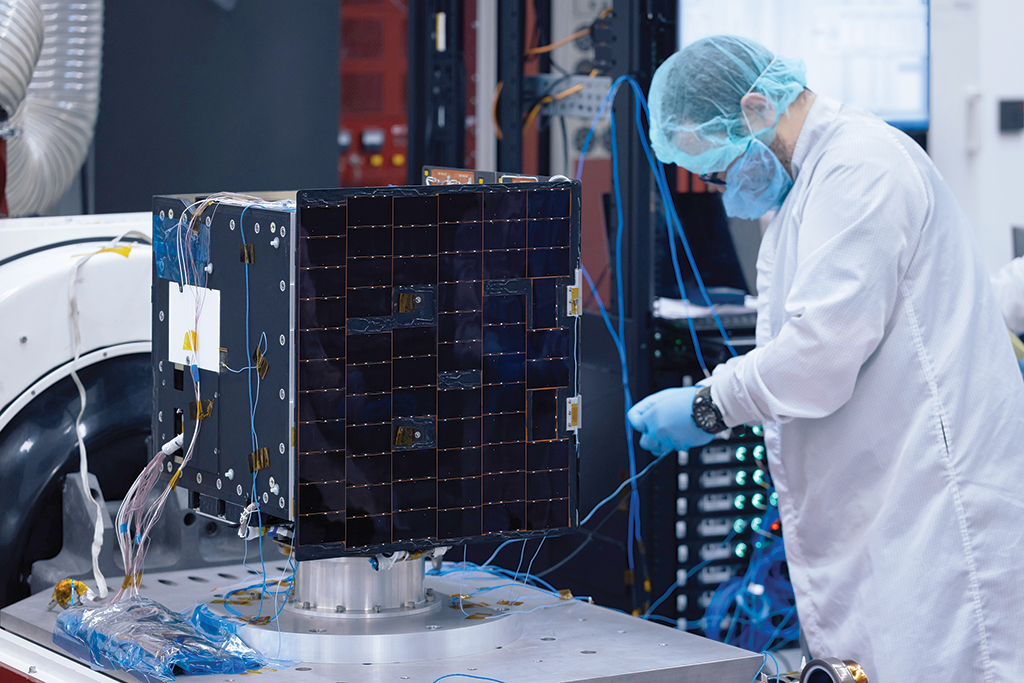
Space Safari would like the space domain awareness satellite to be operational within 48 hr.
Soon, when it enters a new phase, U.S. Space Systems Command’s Space Safari Program Office—as well as satellite builder Millennium Space Systems and launch provider Firefly Aerospace—could get a call at any moment from the U.S. Space Force and be told to launch the Victus Nox satellite into low Earth orbit.
“We don’t know—I don’t even know [and] my leadership doesn’t even know at this time when we are going to be asked to launch,” says Lt. Col. MacKenzie Birchenough, Space Safari’s materiel leader. “They need to be ready anytime over the next six months.”
- The Pentagon wants more tactically responsive space capabilities
- On-orbit spare satellites are a possible resiliency strategy
Millennium Space is wrapping up the build phase of the Victus Nox spacecraft, moving the program toward a six-month hot standby phase. During this period, once given the “go” command, the Space Safari Program Office—set up in 2021 as a “high-speed integrator for specialized space missions”—would have 60 hr. to fuel, load up and then transport Victus Nox, a space domain awareness satellite, from Millennium Space’s El Segundo, California, factory to Vandenberg SFB, a journey of about 140 mi. by aircraft. After arriving at the base, the team would be put on a 24-hr. standby for launch.
The “tactically responsive space” mission is designed to demonstrate a credible response to new, threatening spacecraft from an adversary. It typically takes years to develop a satellite and months to prepare for a launch, but the timeline for Victus Nox has been cut to a little over a year.
“We are definitely shrinking things very drastically,” Birchenough says. The short schedule is an attempt to be “absolutely as realistic as possible,” she says. “We don’t know what threats we might be facing in the coming years. We need to have the ability to respond quickly.”
Space Safari declines to name specific threats, but some Chinese and Russian spacecraft seem to be capable of maneuvering close to U.S. military satellites for spying or even to cause damage using a grappling arm. In recent years, space domain awareness has become a priority for the Space Force as it seeks to understand what adversaries are doing with their spacecraft in regions of space ranging from low Earth orbit all the way to lunar orbits.
Victus Nox, Latin for “conquer the night,” will be for demonstration purposes only, and the spacecraft will not be used to examine any specific threat, Birchenough says. Space Safari declines to talk about the capability of the small satellite.
For the demonstration, Millennium—a Boeing subsidiary—pulled a satellite bus from its production line, modified it and delivered it about eight months after it was awarded the program. The company declines to say which satellite bus was used. The Victus Nox satellite, which recently completed environmental testing, was about the size of a minifridge when viewed by Aviation Week during a tour of the company’s facilities.
Millennium Space is “80% vertically integrated”—it manufactures 22 in-house products—and that helps it rapidly assemble novel satellites, says Andrew Chau, Millennium Space’s advanced projects program manager for the Victus Nox spacecraft.
“Of course, one of our big challenges here is being able to support these rapid timelines,” he says. “We have the advantage at Millennium of having an active production line. By doing so, we were able to leapfrog a lot of those long procurement timelines.”
Keeping all personnel vigilant during the six-month hot standby phase is not realistic, so Space Safari, Millennium Space and launcher Firefly Aerospace have created fallbacks.
“We all have to make sure that we have redundancy in our team, because we don’t know when that call is going to come in,” Birchenough says. “There will be vacations, family events, illnesses and things that happen over the next six months that we have to be prepared for.”
The Victus Nox team is attempting to work out some of the kinks soon with a dry run using a mockup of the space domain awareness satellite. When the real call to launch comes, the team will ferry the satellite to Vandenberg in a Boeing C-17 transport.
“We are also reserving the option to make sure that we can drive it safely to Vandenberg on a short timeline,” Birchenough says. “Los Angeles traffic can also pose issues with that.”
Once at Vandenberg, the team would be put back on standby. “We [will] wait for notification to launch,” Birchenough says. “Once that notification to launch comes, the team has 24 hr. to be ready to launch.”
The satellite is slated to be lofted by a Firefly Aerospace launch vehicle. In October, that company’s Alpha small-satellite booster reached orbit for the first time after launching from Vandenberg. The two-stage Alpha launch system has a lift capacity of 2,580 lb. to low Earth orbit.

Credit: Millennium Space Systems
Birchenough notes that the satellite may not take off exactly within 24 hr.—as it may be delayed due to weather or orbital mechanics—“but the team will absolutely be ready to go.”
Once Victus Nox is on orbit, the team will be tasked with making it mission-capable within 48 hr. “It doesn’t do us much good to get something on orbit quickly if we can’t use it very fast as well,” Birchenough notes.
Victus Nox is a follow-on demonstration to the Space Force’s Tactically Responsive Launch-2, a 2021 mission that put a technology demonstration satellite on orbit within 21 days of being requested. The demonstration used a Northrop Grumman Pegasus XL rocket, carried aloft to 40,000 ft. under the centerline of the company’s “Stargazer” L-1011 aircraft, a modified Lockheed L-1011 TriStar airliner, dropped and then launched into space.
In addition to having a shared interest in tactically responsive space launches, Northrop Grumman and Firefly Aerospace in August announced a partnership to develop a first-stage upgrade for the Antares rocket and a new medium-launch vehicle.
Birchenough says a variety of lessons were learned from Tactically Responsive Launch-2. “One of the big takeaways was that it is much more than just about launch,” she says, noting a need to focus on rapid space vehicle development as well as quickly obtaining launch range and regulatory approval. “Trying to make sure we get all those approvals in a short timeline can be challenging,” she says.
Space Safari sees three ways to fulfill the Space Force’s tactical responsive space needs. In addition to launching rapidly from the ground, the program office is considering ways to keep spare satellites on orbit.
“If the asset was already on orbit, we could move it at the time of need—or effectively turn it on at the time of need—without having to go through the launch phase,” Birchenough says. Space tugs could be used to reposition spare spacecraft rapidly, she adds.
The Space Force also might purchase data from commercial spacecraft operators, Birchenough says. “The ultimate goal here is to get to an enduring, tactically responsive capability in the [2025-26] timeframe,” she says.
While much emphasis has been placed on small launch vehicles and the type’s ability to insert small spacecraft into specific orbits quickly, Space Safari also is considering ways for spacecraft to squeeze at the last minute onto rideshare launches, such as SpaceX’s Transporter missions, Birchenough says.
For its part, Millennium Space is aiming to be able to launch its satellites on any rocket available, CEO Jason Kim says. “We try to have really good relationships with all the launch providers because we want to be launch-vehicle-agnostic,” he says.
Prior to attempting those additional tactically responsive space missions, Space Safari wants to wring out the Victus Nox demonstration to see what can be learned. Birchenough says the hardest part so far has been trying to figure out how to squeeze in so much into such a short schedule. “We are really stressing the system,” she says.
Editor's Note: This article was updated to clarify information about the timing and status of the hot standby phase.
View all news, analysis and insight related to Space Symposium 2023
